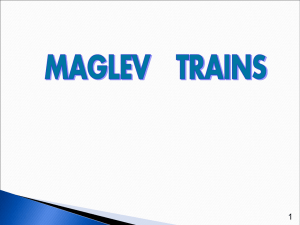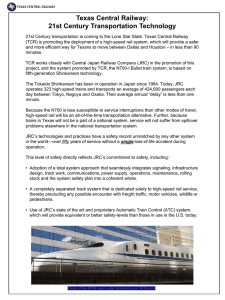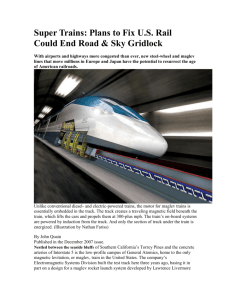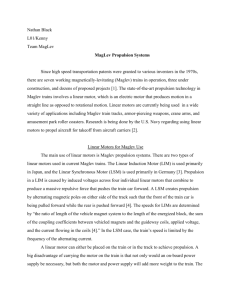1、 TGV--High Speed Railway in France
advertisement
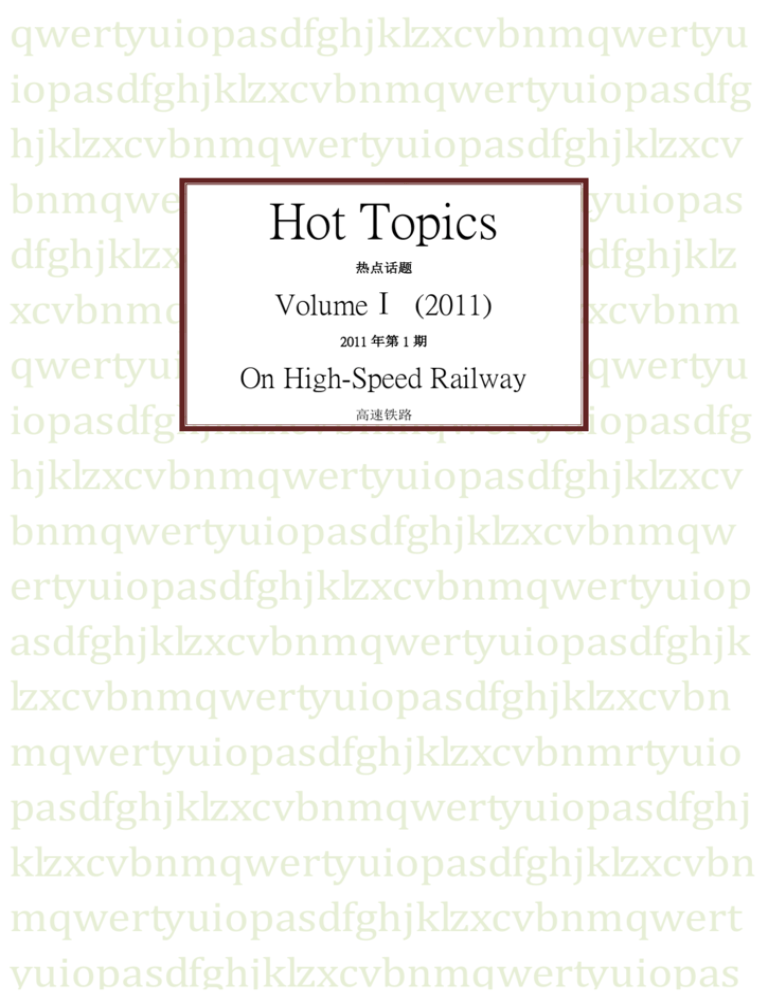
qwertyuiopasdfghjklzxcvbnmqwertyu
iopasdfghjklzxcvbnmqwertyuiopasdfg
hjklzxcvbnmqwertyuiopasdfghjklzxcv
bnmqwertyuiopasdfnmqwertyuiopas
Hot Topics
dfghjklzxcvbnmqwertyuiopasdfghjklz
VolumeⅠ (2011)
xcvbnmqwertyuiopasdfghjklzxcvbnm
qwertyuiopasdfghjklzxcvbnmqwertyu
On High-Speed Railway
iopasdfghjklzxcvbnmqwertyuiopasdfg
hjklzxcvbnmqwertyuiopasdfghjklzxcv
bnmqwertyuiopasdfghjklzxcvbnmqw
ertyuiopasdfghjklzxcvbnmqwertyuiop
asdfghjklzxcvbnmqwertyuiopasdfghjk
lzxcvbnmqwertyuiopasdfghjklzxcvbn
mqwertyuiopasdfghjklzxcvbnmrtyuio
pasdfghjklzxcvbnmqwertyuiopasdfghj
klzxcvbnmqwertyuiopasdfghjklzxcvbn
mqwertyuiopasdfghjklzxcvbnmqwert
yuiopasdfghjklzxcvbnmqwertyuiopas
热点话题
2011 年第 1 期
高速铁路
Foreign Language Books Reading Room
Contents
一、 TGV--High Speed Railway in France ............................... 3
二、 ICE--High-Speed Railway in Germany ............................ 8
三、 JR–Maglev—High-Speed Railway in Japan .................... 9
四、 Maglev—High-Speed Railway in China ........................ 11
2
Editor: Chen Zhaoxia
Mar. 2,2011
Foreign Language Books Reading Room
一、 TGV--High Speed Railway in France
http://en.wikipedia.org/wiki/TGV
The TGV (French: Train à Grande Vitesse, meaning high-speed train) is France's
high-speed rail service, currently operated by SNCF Voyages, the long-distance rail
branch of SNCF, the French national rail operator.
It was developed during the 1970s by GEC-Alsthom (now Alstom) and SNCF.
Although originally designed to be powered by gas turbines, the TGV prototypes
evolved into electric trains with the petrol crisis of 1973. Following the inaugural
TGV service between Paris and Lyon in 1981, the TGV network, centred on Paris,
has expanded to connect cities across France and in adjacent countries.
A TGV test train set the record for the fastest wheeled train, reaching 574.8 km/h
(357.2 mph) on 3 April 2007. At mid 2011, the TGV is the fastest conventional train
in the world, reaching 320 km/h (200 mph) on the "LGV Est".
A TGV service held the record for the fastest scheduled rail journey with a start to
stop average speed of 279.4 km/h (173.6 mph), which was temporarily surpassed by
the Chinese CRH service Harmony express on the Wuhan–Guangzhou High-Speed
Railway from December 2009 until July 2011.
The success of the first line led to an expansion of the network, with new lines built in
the south, west, north and east of the country. Eager to emulate the success of the
French network, neighbouring countries such as Belgium, Italy, Spain and Germany
built their own high-speed lines. TGVs link with Switzerland, Italy, Germany and
Belgium through the French network, with Belgium, Germany and the Netherlands
through the Thalys network, and the Eurostar network links France and Belgium with
the United Kingdom. Several lines are planned, including extensions within France
and to surrounding countries. Cities such as Tours have become a part of a "TGV
commuter belt".
In 2007, SNCF generated profits of €1.1 billion (approximately US$1.75 billion or
£875 million) driven largely by higher margins on the TGV network.
HistoryThe idea of the TGV was first proposed in the 1960s, after Japan had begun
construction of the Shinkansen (also known as the bullet train) in 1959. At the time
the French government favoured new technologies, exploring the production of
hovercraft and the Aérotrain air-cushion vehicle. Simultaneously, SNCF began
3
Editor: Chen Zhaoxia
Mar. 2,2011
Foreign Language Books Reading Room
researching high speed trains that would operate on conventional track. In 1976 the
government agreed to fund the first line. By the mid-1990s the trains were so popular
that SNCF president Louis Gallois declared TGV "The train that saved French
railways."
It was originally planned that the TGV, then standing for très grande vitesse ("very
high speed") or turbine grande vitesse ("high-speed turbine"), would be propelled by
gas turbine-electric locomotives. Gas turbines were selected for their small size, good
power-to-weight ratio and ability to deliver high power over an extended period. The
first prototype, TGV 001, was the only TGV constructed with this engine: following
the increase in the price of oil during the 1973 energy crisis, gas turbines were
deemed uneconomic and the project turned to electricity from overhead lines. The
electricity was to be generated by France's new nuclear power stations.
TGV 001 was not a wasted prototype: its gas-turbine powerplant was only one of
many technologies for high-speed rail travel. It also tested high speed brakes, needed
to dissipate the large amount of kinetic energy of a train at high speed, high-speed
aerodynamics, and signalling. It was articulated, i.e. two adjacent carriages shared a
bogie, allowing free yet controlled motion with respect to one another. It reached 318
km/h (198 mph), which remains the world speed record for a non-electric train. Its
interior and exterior were styled by British-born designer Jack Cooper, whose work
formed the basis of early TGV designs, including the distinctive nose shape of the
first power cars.
Changing the TGV to electric traction required a significant design overhaul. The first
electric prototype, nicknamed Zébulon, was completed in 1974, testing features such
as innovative body mounting of motors, pantographs, suspension and braking. Body
mounting of motors allowed over 3 tonnes to be eliminated from the power cars and
greatly reduced the unsprung weight. The prototype travelled almost 1,000,000 km
(620,000 mi) during testing.
In 1976 the French government funded the TGV project, and construction of the LGV
Sud-Est, the first high-speed line (French: ligne à grande vitesse), began shortly
afterwards. The line was given the designation LN1, Ligne Nouvelle 1, (meaning
New Line 1).
After two pre-production trainsets (nicknamed Patrick and Sophie) had been tested
and substantially modified, the first production version was delivered on 25 April
1980.
The TGV opened to the public between Paris and Lyon on 27 September 1981.
Contrary to its earlier fast services, SNCF intended the TGV service for all types of
4
Editor: Chen Zhaoxia
Mar. 2,2011
Foreign Language Books Reading Room
passengers, with the same ticket price as for trains running on the parallel
conventional line. To counteract the popular misconception that the TGV would be
another premium service for business travellers, SNCF started a major publicity
campaign focusing on the speed, frequency, reservation policy, normal price, and
broad accessibility of the service. This commitment to a democratised TGV service
was further enhanced in the Mitterrand era with the promotional slogan "Progress
means nothing unless it is shared by all". The TGV was considerably faster than
normal trains, cars, or aeroplanes. The trains became widely popular, the public
welcoming fast and practical travel.
Further LGVs have opened: the LGV Atlantique (LN2) to Tours/Le Mans
(construction begun 1985, in operation 1989); the LGV Nord-Europe (LN3) to Calais
and the Belgian border (construction begun 1989, in operation 1993); the LGV
Rhône-Alpes (LN4), extending the LGV Sud-Est to Valence (construction begun
1990, in operation 1992); and the LGV Méditerranée (LN5) to Marseille
(construction begun 1996, in operation 2001). The LGV Est (LN6) from Paris to
Strasbourg was inaugurated on 15 March 2007, and opened to the public in the
summer of 2007. The LGV Perpignan-Figueras (LN7) opened on December 2010.
And in 2011 the LGV Rhin-Rhône (LN8) first phase opening. In its first month of
operation, more than 1,000,000 passengers traveled on the line. High speed lines
based on LGV technology connecting with the French network have been built in
Belgium, the Netherlands and the United Kingdom.
A TGV Duplex trainset coupled to a Reseau trainset leaving Paris Gare de LyonThe
Eurostar service began operation in 1994, connecting continental Europe to London
via the Channel Tunnel with a version of the TGV designed for use in the tunnel and
in the United Kingdom. The line used the LGV Nord-Europe from the outset. The
first phase of the British High Speed 1 line, or Channel Tunnel Rail Link, was
completed in 2003, and the second phase was completed in November 2007. The
fastest trains take 2 hours 15 minutes on the London-Paris and 1 hour 51 minutes on
the London-Brussels routes.
MilestonesThe TGV was the world's fourth commercial high speed train service and
third standard gauge high speed train service,[11] after Japan's Shinkansen, which
first connected Tokyo and Osaka on 1 October 1964 (full service in 1975) and
Russian ER200 around 1964 (full service in 1984), and Britain's Intercity 125,
intended for the UK's main lines such as the East Coast Mainline and which entered
service in 1976. The TGV currently holds the world speed record for conventional,
wheel/rail trains. On 3 April 2007 a modified TGV POS train reached 574.8
kilometres per hour (357.2 mph) under test conditions on the LGV Est.
5
Editor: Chen Zhaoxia
Mar. 2,2011
Foreign Language Books Reading Room
TGV, Record runsThe voltage on the test track between Paris and Strasbourg was
boosted to 31 kV and extra ballast was tamped onto the right-of-way. It beat the 1990
world speed record of 515.3 km/h (320.2 mph), set by a similarly shortened train (two
power cars and three passenger cars), along with unofficial records set during weeks
preceding the official record run. The test was part of an extensive research
programme by Alstom.
The TGV was in 2007 the world's fastest conventional scheduled train: one journey's
average start-to-stop speed from Lorraine-TGV to Champagne-Ardenne-TGV is
279.3 km/h (173.5 mph). This record was surpassed on December 26, 2009 by the
newly opened Wuhan-Guangzhou High-Speed Railway[14] in China where the fastest
scheduled train covered 922 km (573 mi) at an average speed of 312.54 km/h (194.2
mph). However, on July 1, 2011 in order to save energy and reduce operating costs
the maximum speed of Chinese high-speed trains was reduced to 300 km/h, and the
average speed of the fastest trains on the Wuhan-Guangzhou High-Speed Railway
was reduced to 272.68 km/h (169 mph), slower than the TGV.
A Eurostar train broke the record for the longest non-stop high-speed international
journey in the world on 17 May 2006 carrying the cast and filmmakers of The Da
Vinci Code from London to Cannes for the Cannes Film Festival. The
1,421-kilometre (883 mi) journey took 7 hours 25 minutes (average of 191.6 km/h or
119 mph).
The record for the fastest long distance run was set by a TGV Réseau train travelling
from Calais-Frethun to Marseille (1067.2 km, 663 mi) in 3 hours 29 minutes (306
km/h or 190 mph) for the inauguration of the LGV Méditerranée on 26 May
2001.[16]
RidershipOn 28 November 2003 the TGV network carried its one-billionth passenger,
second only to the Shinkansen's five billionth passenger in 2000. The two-billion
mark is expected to be reached in 2010.
Excluding international traffic, the TGV system had carried 98 million passengers
during 2008, an increase of 8 million (9.1%) on the previous year.[17]
Track designTGV track construction is similar to that of normal railway lines, but
with a few key differences. The radii of curves are larger so that trains can traverse
them at higher speeds without increasing the centripetal acceleration felt by
passengers. The radii of LGV curves have historically been greater than 4 km (2.5 mi).
New lines have minimum radii of 7 km (4.3 mi) to allow for future increases in speed.
Lines used only for high-speed traffic can incorporate steeper gradients than normal.
6
Editor: Chen Zhaoxia
Mar. 2,2011
Foreign Language Books Reading Room
This facilitates the planning of LGVs and reduces their cost of construction. The high
power/weight and adhesive weight/total weight ratios of TGVs allow them to climb
much steeper grades than conventional trains. The considerable momentum at high
speeds also helps to climb these slopes very fast without greatly increasing their
energy consumption. The Paris-Sud-Est LGV has grades of up to 3.5% (on the
German NBS high-speed line between Cologne and Frankfurt they reach 4%). On a
line reserved for high-speed trains it is possible to have greater superelevation (tilt),
since all trains are travelling at the same (high) speed and a train stopping on a curve
because of a stop signal is a very rare event. Curve radii in high-speed lines have to be
large, but increasing the superelevation allows for tighter curves while supporting the
same train speed. Allowance for tighter curves can reduce construction costs by
reducing the number and/or length of tunnels or viaducts and the volume of
earthworks.
Track alignment is more precise than on normal railway lines, and ballast is in a
deeper-than-normal profile, resulting in increased load-bearing capacity and track
stability. LGV track is anchored by more sleepers or ties per kilometre than normal,
and all are made of concrete, either mono- or bi-bloc, the latter consisting of two
separate blocks of concrete joined by a steel bar. Heavy rail (UIC 60) is used and the
rails themselves are more upright, with an inclination of 1 in 40 as opposed to 1 in 20
on normal lines. Use of continuously welded rails in place of shorter, jointed rails
yields a comfortable ride at high speed, without the "clickety-clack" vibrations
induced by rail joints.
The points or switches on LGVs are different from those on the lignes classiques.
Every LGV set of points incorporates a swingnose crossing (coeur à pointe mobile)
or 'moveable point frog' which eliminates the gap in rail support as wheels of a train
pass over the 'frog' of conventional points, causing shock and vibration. Eliminating
shock and vibration makes the passage of a TGV over an LGV switch imperceptible
to passengers, and reduces stresses on wheels and track. In addition, LGV switches
permit much higher speeds. Crossover switches on LGV's permit a TGV to move
from one track to the adjacent track at 160 km/h (99 mph). At junctions, such as the
junction on the TGV Atlantique where the line to Le Mans diverges from the line to
Tours, special points designed for higher speeds are installed which permit a
diverging speed of 220 km/h (137 mph) .
The diameter of tunnels is greater than normally required by the size of the trains,
especially at entrances. This limits the effects of air pressure changes, which could be
problematic at TGV speeds.
Traffic limitationsLGVs are reserved primarily for TGVs. One reason for this is that
capacity is sharply reduced when trains of differing speeds are mixed. Passing freight
7
Editor: Chen Zhaoxia
Mar. 2,2011
Foreign Language Books Reading Room
and passenger trains also constitute a safety risk, as cargo on freight cars can be
destabilised by the air turbulence caused by the TGV.
The axle load of trains permitted to operate on LGV lines in France is limited to 17
tons. Conventional trains hauled by locomotives are not allowed on French LGVs,
since the axle load of a typical European electric locomotive exceeds 20 tons;
however, this limitation is not imposed on high-speed lines in other countries, such as
Germany. Freight trains are not permitted on French LGVs. TGV 'power cars,' which
are lightweight streamlined locomotives at both ends of TGV trainsets, satisfy the 17
ton limit. But when the double-deck TGV Duplex trains were introduced in the 1990s,
special design efforts were needed (a 'hunt for kilograms,' chasse aux kilos) to reduce
weight to ensure that the double-deck passenger cars conformed to the 17 ton limit.
The 17 ton axle load limit is imposed to prevent heavyweight rolling stock from
prematurely damaging the very accurate track alignment ('surface') on LGVs required
for high-speed train operation.
The steep gradients common on LGVs would limit the weight of slow freight trains.
Slower trains would also mean that the maximum track cant (banking on curves)
would be limited, so for the same maximum speed, a mixed-traffic LGV would need
to be built with curves of even larger radius. Such track would be much more
expensive to build and maintain. Some stretches of less-used LGV are routinely
mixed-traffic, such as the Tours branch of the LGV Atlantique, and the planned
Nîmes/Montpellier branch of the LGV Mediterranée. The British High Speed 1 from
the Channel Tunnel to London has been built with passing loops to support freight use,
but this facility has not been used.
二、 ICE--High-Speed Railway in Germany
http://www.europeanrailguide.com/trains/ice.html
The Deutsche Bahn AG (or German Rail) is the provider of one of Europe’s most
advanced and comfortable rail networks; a network which includes the high-speed
ICE (Inter-City Express) trains used by 65,000 people every day in Germany and
beyond. These ICE trains have managed to slice hours off the journey times between
popular destinations such as Hamburg in the far north of the country and Munich
nestled in the south. Hamburg and Munich are just 6 hours apart whilst the journey
from Hamburg to Frankfurt takes just 3 hours 30 minutes.
First introduced to the nation in the summer of 1991, the ICE trains have been
connecting all of Germany’s major train destinations via high-speed train lines and at
speeds of up to 175mph ever since. The ICE service operates primarily in Germany
8
Editor: Chen Zhaoxia
Mar. 2,2011
Foreign Language Books Reading Room
serving 32 destinations, though there are also some ICE rail links to Switzerland,
Austria, Belgium, the Netherlands and France. It was in June 2007 that a new line was
opened between Paris and Frankfurt/Stuttgart which is being jointly run by Deutsche
Bahn and SNCF. ICE operates on the Paris - Frankfurt branch of the line and SNCF's
TGV runs on the Paris - Frankfurt branch. At the end of 2007 there was a further
development when the latest ICE trains were brought into service for the lines from
Berlin to Århus and Copenhagen in Denmark.
As well as comprehensive catering facilities including on board restaurants serving
hot food with proper crockery and restaurant seating, the ICE trains offer additional
luxuries such as in-seat video screens (in first class), audio systems, and electrical
sockets for laptops. Business people can also use the on-board fax machines and
telephones.
The sleek red and white trains travel with practically no engine noise and with
pressurized carriages preventing the ear-discomfort that can arise when traveling
through tunnels. With the latest trains incorporating tilting technology, the top speeds
of 175mph are likely to increase further, whilst maintaining the frequency and
reliability of services that make train travel in Germany a real pleasure.
三、 JR–Maglev—High-Speed Railway in Japan
http://en.wikipedia.org/wiki/JR%E2%80%93Maglev
JR-Maglev is a magnetic levitation train system developed by the Central Japan
Railway Company and Railway Technical Research Institute (association of Japan
Railways Group). JR-Maglev MLX01 (X means experimental) is one of the latest
designs of a series of Maglev trains in development in Japan since the 1970s. It is
composed of a maximum five cars to run on the Yamanashi Maglev Test Line. On 2
December 2003, a three-car train reached a maximum speed of 581 km/h (361 mph)
(world speed record for railed vehicles) in a manned vehicle run.
The JR-Maglev system uses an Electro-dynamic Suspension (EDS) system. The
maglev-trains have superconducting magnetic coils, and the guide ways contain
levitation coils. As the train moves, its moving magnetic fields create a current in the
levitation coils because of the magnetic field induction effect. These currents create a
magnetic field that interacts with the magnetic field of the superconductive coils to
create a force that holds up and stabilises the train.
Technology
9
Editor: Chen Zhaoxia
Mar. 2,2011
Foreign Language Books Reading Room
The trains use a levitation system, a guide system, and a driving system.
The different prototypes have worked in slightly different ways, but the current track
has a series of figure-of-8 wound coils along both sides that are also cross-connected
with wires that go underneath the track.
When the trains run at high speed, if the magnetic field of the approach of the
superconducting magnetic coils is centered then the electrical potential is balanced
and no currents are induced.
However, typically, the train is running slightly below the centre of the coils due to
gravity. Then the electrical potential is no longer balanced, and this causes a current
that creates a reactive magnetic field that opposes the superconducting magnet's pole
(in accordance with Lenz's law) and a pole above that attracts it, and so the train is
pushed and pulled upwards, and prevented from falling.
Levitation coils on the guide way generate guiding and stabilizing forces also. If the
train moves to the left, then currents are induced due to the cross-connections between
the track coils that push and pull it straight.
EDS allows larger gaps than EMS, but requires support wheels for relatively low
speeds, when it can't produce a large levitation force. The wheels retract once the train
reaches 150 km/h (93 mph). JR-Maglev floats 10 centimeters (3.94 in) above the
guideway.
JR-Maglev is driven by a Linear Synchronous Motor (LSM) System, which powers
the coils at the guide way.
Miyazaki Test TrackAfter maglev tests moved to Yamanashi Prefecture, the Railway
Technical Research Institute (RTRI) began in 1999 to allow the test of ground effect
trains based on wing-in-ground-effect (WIG) at the former site in Hyūga City,
Miyazaki Prefecture.[4]
Yamanashi Test TrackYamanashi Experiment Lines are facilities that currently have a
practical use. It includes about 18.4 km (11.4 mi) of track (including 16.0 km (9.9 mi)
of tunnels). The test track is currently being extended from 18.4 to 42.8 km (11.4 to
26.6 mi) with completion expected for 2013/14. This is part of the planned Chūō
Shinkansen connecting Tokyo, Nagoya, and Osaka. 14 pre-production L0 Series
Shinkansen will be built by Mitsubishi Heavy Industries and Nippon Sharyo, a
subsidiary of JR Central.
History
10
Editor: Chen Zhaoxia
Mar. 2,2011
Foreign Language Books Reading Room
ML500 1979 world speed record holder of 517 kilometres per hour (321 mph) on
display in National Transportation Museum in Osaka, Japan.
MLX01-1 at Expo 2005
MLU001's superconducting magnet and a liquid helium tank on top of it1962 – Initial
technology research was started.
1977 – The experiment run was started at Miyazaki tracks.
1995 - Experiments cease on Miyazaki tracks.
1997 – The experiment run was started at Yamanashi tracks (MLX01) on April.
2004 – Number of passengers for Maglev trial ride exceeded 80,000 people. Test of
two trains passing each other at a maximum relative speed of 1,026 km/h (638 mph).
2005 - Crown Prince Naruhito experienced Maglev trial ride.
四、 Maglev—High-Speed Railway in China
(一) The Shanghai Maglev Train
http://en.wikipedia.org/wiki/Maglev
The Shanghai Maglev Train or Shanghai Transrapid is a magnetic levitation train, or
maglev line that operates in Shanghai, China. It is the first commercially operated
high-speed magnetic levitation line in the world. The train line was designed to
connect Shanghai Pudong International Airport and the outskirts of central Pudong
where passengers could interchange to the Shanghai Metro to continue their trip to the
city center.
Construction of the line began in 1 March 2001 and public commercial service
commenced on 1 January 2004. The top operational commercial speed of this train is
431 km/h (268 mph), making it the world's fastest train in regular commercial
services since its opening in 2004, faster than TGV in France and also faster than the
latest CRH conventional wheel train in China at 350 km/h (217 mph). During a
non-commercial test run on 12 November 2003, a maglev train achieved a Chinese
record speed of 501 km/h (311 mph).[2] The top operational speed of 431 km/h (268
mph) is also faster than the top speed of any production automobile (except for the
Bugatti Veyron Super Sport, which has roughly the same top speed), Formula One car,
or MotoGP super bikes.
The train set and tracks were built by Siemens. Two commercial maglev systems had
predated the Shanghai system—the Birmingham Maglev in the United Kingdom and
the Berlin M-Bahn—both were low-speed operations and had closed before the
opening of the Shanghai Maglev Train.
11
Editor: Chen Zhaoxia
Mar. 2,2011
Foreign Language Books Reading Room
The line is often considered part of the Shanghai Metro network, although there is a
separate fare system.
Background
Plan Overview Of Shanghai Maglev Route
Longyang Road maglev station
Speed indicator shown in each carThe line runs from Longyang Road station in
Pudong to Pudong International Airport; The Pudong International Airport station
provides a transfer to Line 2, but the Longyang Road station provides access to Line 2
and LIne 7. At full speed, the journey takes 7 minutes and 20 seconds to complete the
distance of 30 km (18.6 mi), although some trains in the early morning and late
afternoon take about 50 seconds longer. A train can reach 350 km/h (217 mph) in 2
minutes, with the maximum normal operation speed of 431 km/h (268 mph) reached
thereafter.
Hans-Dieter Bott, vice president of Siemens when they won the contract to build the
rail link, stated that "Transrapid views the Shanghai line, where the ride will last just
eight minutes, largely as a sales tool. This serves as a demonstration for China to
show that this works and can be used for longer distances, such as Shanghai to
Beijing".[3] However, the decision was eventually made to implement the
Beijing-Shanghai Express Railway with conventional high-speed technology, and to
build maglev tracks for the shorter Shanghai-Hangzhou trip instead.
Operation
Shanghai Maglev "driver" in the train cabin
Shanghai Maglev VIP cabin interiorThe line is operated by Shanghai Maglev
Transportation Development Co., Ltd. As of May 2008[update], the line operates
daily from 6:45 AM to 9:30 PM, with services every 8 to 10 minutes. A one-way
ticket costs ¥50 (US$7.27), or ¥40 ($5.81) for those passengers holding a receipt or
proof of an airline ticket purchase. A round-trip return ticket costs ¥80 ($11.63) and
VIP tickets cost double the standard fare.
Following the opening, overall maglev train ridership levels were at 20% of capacity.
The levels were attributed to limited operating hours, the short length of the line, high
ticket prices and that it "virtually goes nowhere", terminating at Longyang Road in
Pudong another 20 min by subway from the city centre.
Daytime hours 06:45–08:45 09:00–10:45 11:00–12:45 13:00–16:45 17:00–21:40
Journey time (minutes) 8:10 7:20 8:10 7:20 8:10
Maximum speed 301 km/h (187 mph) 431 km/h (268 mph) 301 km/h (187 mph) 431
km/h (268 mph) 301 km/h (187 mph)
12
Editor: Chen Zhaoxia
Mar. 2,2011
Foreign Language Books Reading Room
Average speed 224 km/h (139 mph) 251 km/h (156 mph) 224 km/h (139 mph) 251
km/h (156 mph) 224 km/h (139 mph)
Interval 15 minutes 15 minutes 15 minutes 15 minutes 20 minutes
ConstructionThe Shanghai Transrapid project took ¥10 billion (US$1.33bn) and two
and a half years to complete. The line is 30.5 km (18.95 mi) track and has a further
separate track leading to a maintenance facility.
ExtensionsMain article: Shanghai-Hangzhou Maglev Train
In January 2006, the Shanghai-Hangzhou Maglev Train extension project was
proposed by the Shanghai Urban Planning Administrative Bureau. The extension
would continue the existing line towards Shanghai Hongqiao International Airport,
running via Shanghai South Railway Station and the Expo 2010 site, with a possible
continuation towards Hangzhou. The extension would allow transferring between the
two airports — located 55 km (34 mi) apart — in approximately 15 minutes.
The plan for the extension to Hangzhou was first approved by the central government
in February 2006, with a planned date of completion in time for 2010. Work was
suspended in 2008, owing to public protests over radiation fears.[6] According to
China Daily, as reported on People's Daily Online 27 February 2009, the Shanghai
municipal government is considering building the maglev line underground to allay
the public's fear of electromagnetic pollution and the final decision on the maglev line
had to be approved by the National Development and Reform commission.
The extension to Hangzhou was finally approved in March 2010, with construction to
start in 2010.[7] The new link will be 199.5 km (124 mi) long, 24 km (15 mi) longer
than the original plan. The top speed is expected to be 450 km/h (280 mph) but
limited to 200 km/h (124 mph) in built-up areas.
In October 2010 the Shanghai–Hangzhou High-Speed Railway was opened that
brought the travelling time between the two cities down to 45 minutes. Plans for a
Maglev link are suspended, as an official has revealed.[8]
Incidents On 11 August 2006, a Maglev train compartment caught fire at 2:40 p.m.,
after having left Pudong International Airport in the direction of Pudong Longyang
Road Station. There were no injuries aboard. Preliminary reports indicated that an
electrical problem may have been the cause.
(二) China developing 600 mph airless maglev high-speed
train
http://www.smartplanet.com/blog/smart-takes/china-developing13
Editor: Chen Zhaoxia
Mar. 2,2011
Foreign Language Books Reading Room
600-mph-airless-maglev-high-speed-train/9594
China developing 600 mph airless maglev high-speed train
By Andrew Nusca | August 9, 2010, 8:19 AM PDT
55
Comments.more
+EmailPrintDel.icio.usDiggLinkedInRedditTechnorati..55Comments.more
+EmailPrintDel.icio.usDiggLinkedInRedditTechnorati..
High-speed rail just got a whole lot faster.
China is reportedly developing a high-speed train that will travel at up to 1,000
kilometers per hour, or approx. 621 miles per hour, through Maglev lines in airless
tubes underground.
Researchers at the National Power Traction Laboratory of Southwest Jiaotong
University reportedly told Beijing-based Legal Evening News that they were working
on a prototype “vactrain” with an average speed of 500 to 600 kilometers per hour
(approx. 311 to 373 miles per hour.)
The researchers say the technology could be in use within a decade. In the meantime,
a smaller model train may be introduced in two or three years, they said.
The technology at the heart of the train is Maglev, short for magnetic levitation,
technology. A concept that’s been around for more than 100 years, Maglev tech
entails the suspension of a train via powerful magnets to remove the friction present at
the rails of conventional trains.
The catch with maglev technology is that there’s still friction from the air rushing past
the train as it hurtles down the tracks. To date, the fastest Maglev train managed about
361 miles per hour — not much faster than a conventional high-speed train.
But an airless tube — a vacuum — would remove that air drag, allowing for
impressive speeds. (The trains themselves will contain pressurized air, just like an
airplane.) A cheaper alternative to removing the air completely is to depressurize it,
the researchers say.
Inventor and ET3 CEO Daryl Oster holds the U.S. patent for Evacuated Tube
Transport, or ETT, technology. As you might expect, Oster has reportedly been
working with Chinese researchers Shen Zhiyun, Zhang Yaoping and Wang Jiasu at
the university on the concept.
14
Editor: Chen Zhaoxia
Mar. 2,2011
Foreign Language Books Reading Room
The researchers say the train is cost-competitive with a traditional high-speed train
because it has a smaller tunnel and requires less boring.
15
Editor: Chen Zhaoxia
Mar. 2,2011

